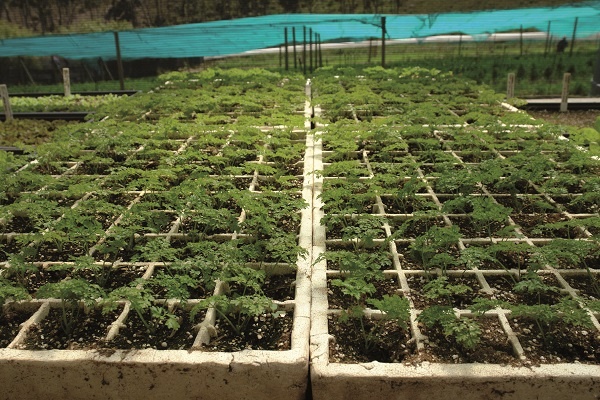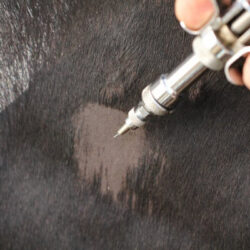If you’re a farmer – new or already established – producing crops, you need to know how to handle and store pesticides and chemicals safely and how to protect your workers, and yourself, while doing so.
IT IS THE DUTY OF THE EMPLOYER, IN THIS CASE THE FARMER, TO PROVIDE AND MAINTAIN A SAFE, HEALTHY WORKING ENVIRONMENT.
Some farmers think that adhering to safety measures, such as wearing personal protective equipment (PPE) when applying pesticides, is an unnecessary production cost. But many on-farm accidents could be avoided if farmers and workers knew how to handle pesticides correctly.
If an employee (or the farmer) falls ill as a result of poor handling of pesticides, the medical treatment could be very costly. And a farmer could lose an entire crop if pesticides are not used correctly.
PERSONAL PROTECTIVE EQUIPMENT (PPE)
Anyone who applies pesticides to crops must wear a one-piece, long-sleeved pair of overalls, with a hood.
The overalls should be as cool as possible to avoid heat exhaustion and dehydration.
And the wearer should drink at least 500 ml water every hour.
Gumboots are also essential, and trouser legs should be pulled over the tops of the boots.
Boots should be made from a synthetic material, not leather, and they should be unlined.
Leather boots would absorb any chemicals spilt or accidentally sprayed onto them.
Tight-fitting eye protection is also important as the mucous membranes of the eyes absorb pesticides more easily than any other part of the body.
Look for anti-mist goggles, to improve visibility and rinse, dry (out of the sun) and store goggles (in a plastic bag) after each use.
Gloves should be synthetic and resistant to a wide variety of chemicals.
Surgical gloves are not acceptable, as they are too thin.
Employees and farmers often use inexpensive thin paper masks to prevent the inhaling of chemicals, but these masks don’t provide adequate protection.
Masks must have a proper combination filter for a variety of pesticides.
Masks should never be stored in a pesticide shed, as they will absorb the vapours.
It’s not advisable to use a filter that’s past its expiry date.
To avoid this, a farmer should write the expiry date of the filter on the mask, using a water-resistant marker.
If you start smelling or tasting the chemicals while wearing the mask, replace it.
STORAGE
A pesticide storeroom must have:
Good ventilation to prevent a build-up of toxic vapours.
A smooth cement floor so spills can be cleaned up easily.
Good lighting for reading labels and measuring accurately.
A wash basin.
It’s not advisable to store insecticides and herbicides in the same room, and definitely not all together – alphabetically, for example. You could make a mistake and spray the wrong one onto a crop.
Chemicals should also be stored in a locked room, out of reach of children and where thieves can’t get to them. Pesticides are expensive and if they are stolen, it would be very costly to the farmer.
MIXING CHEMICALS
When you are mixing chemicals, always read the instructions on the label carefully.
Using too much wastes money, and using too little could be ineffective.
The entire PPE outfit should be put on before mixing chemicals.
If they come into contact with the skin, remove them quickly with cold – not hot – water and soap.
Hot water increases the chemical’s penetration into the affected area.
There are a number of ways to dispose of any mixed chemicals left over after spraying has been completed.
Storage is not recommended, as the pesticides are likely to be ineffective with the next spraying.
Some farmers continue spraying until they have used up everything, but if you are using a tractor sprayer, your best course of action would be to dilute the mixture with 5 times the quantity of water called for, and spray it along the side of the road.
Empty containers should not be reused, as the previous contents could have been toxic.
Rinse the container 3 times, then punch holes in them and finally discard them along with other municipal waste.
DOCUMENTATION
Farmers should keep careful records regarding pesticide handling, safety and the supplying of PPE, to avoid any possible legal issues.
Firstly, keep a PPE register to keep track of who has received protective gear.
Each worker must confirm, by a signature, that he was trained in the use of PPE.
Keep a work exposure record too, detailing which pesticides were used, and for how long workers were exposed to them.
It’s a good idea for new workers to have a blood test to determine if he was previously exposed to pesticides.
A blood test when the worker leaves the farmer’s employment is also necessary to prove that the farmer didn’t put an employee at risk.
MORE SAFE HANDLING TIPS AND SUGGESTIONS
Each employee must have his or her own set of personal protective equipment.
Safety equipment is costly and this will ensure that everyone uses their equipment
responsibly.
All employees should be told why, and how, to use PPE.
This is important as the farmer won’t always be there to check if protective gear is used correctly.
After spraying, wash the entire body with soap and water and ensure that the overall hood/cap is also cleaned.
Recent cases where farm workers became ill found that while protective overalls were washed, the hoods were not, which caused workers to absorb pesticides through them.
Wear gloves if you are washing protective gear by hand.
Also read:
Managing disease in hydroponic systems
Hydroponic farming: Tunnels limit pests – but watch out for these




